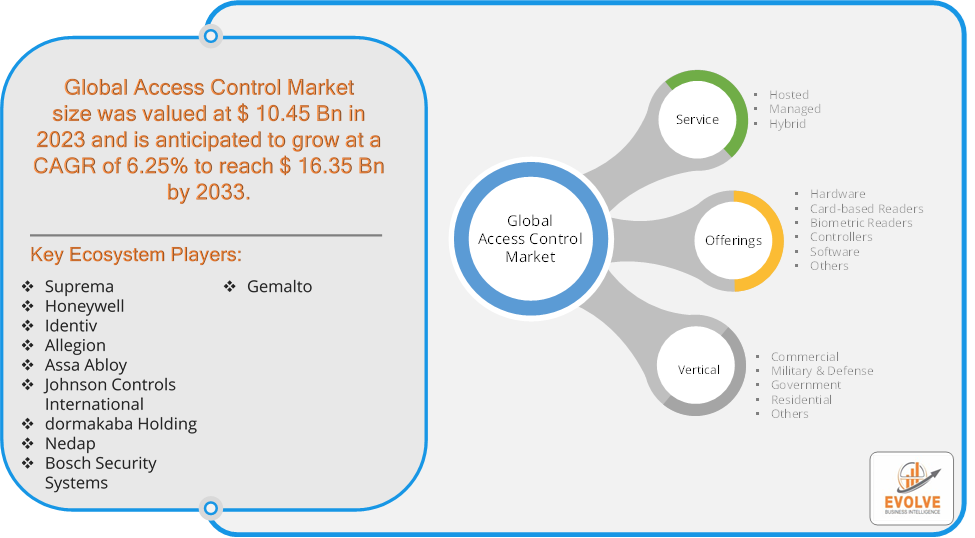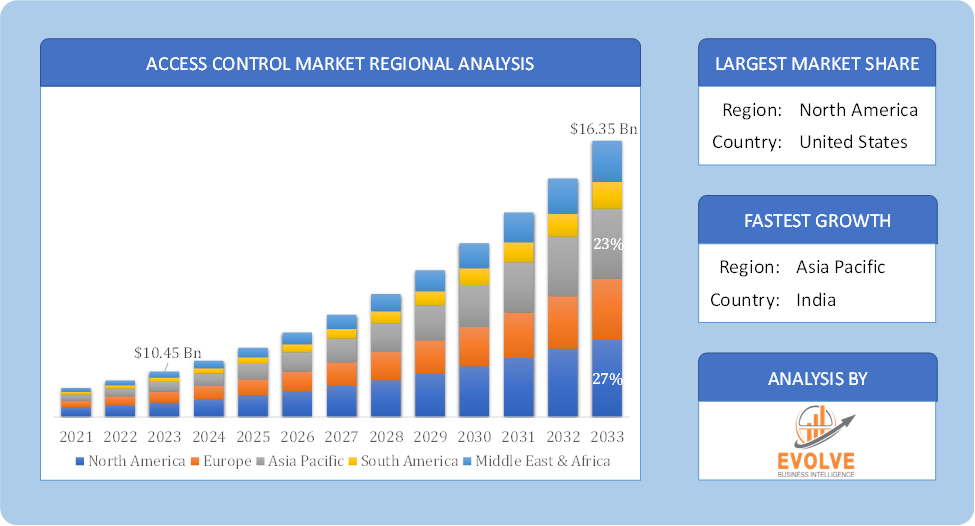Access Control Market Overview
The Access Control Market Size is expected to reach USD 16.35 Billion by 2033. The Access Control Market industry size accounted for USD 10.45 Billion in 2023 and is expected to expand at a compound annual growth rate (CAGR) of 6.25% from 2023 to 2033. The Access Control Market refers to the sector of the security industry that deals with the provision of systems and solutions for regulating who can enter or use resources in a given environment. These systems and solutions are designed to enhance security by ensuring that only authorized individuals can gain access to specific areas, information, or assets.
The Access Control Market is driven by various factors including the growing need for security in residential, commercial, and industrial sectors, increasing instances of data breaches and security threats, advancements in technology, and regulatory requirements. Trends in the market may also focus on the adoption of smart and connected devices, the integration of artificial intelligence and machine learning for predictive security measures, and the shift towards cloud-based solutions.
Global Access Control Market Synopsis
 COVID-19 Impact Analysis
COVID-19 Impact Analysis
The COVID-19 pandemic had significant impacts on the Access Control Market. With the emphasis on reducing physical contact to prevent virus transmission, there was a surge in demand for contactless access control technologies. Solutions such as facial recognition, RFID, and mobile-based access systems gained popularity as they minimize physical contact compared to traditional card swipes or keypad entries. The pandemic heightened awareness of health and safety in various environments. Access control systems were increasingly integrated with health screening solutions, such as temperature checks and health status verification, to enhance overall safety protocols. The shift towards remote work and the need for flexible access management solutions led to an increased adoption of cloud-based access control systems. These systems offer remote monitoring and management capabilities, which are particularly useful in a distributed workforce scenario. The pandemic caused disruptions in global supply chains, affecting the availability and delivery of access control hardware and components. This led to delays and increased costs for implementing or upgrading access control systems. As remote work became more prevalent, there was a rise in the need for secure digital access solutions. Organizations looked for ways to securely manage remote access to systems and data, leading to growth in logical access control solutions and secure authentication methods.
Access Control Market Dynamics
The major factors that have impacted the growth of Access Control Market are as follows:
Drivers:
Ø Technological Advancements
Innovations in technology, such as biometric recognition (fingerprint, facial, and iris recognition), RFID, and mobile access solutions, are expanding the capabilities and applications of access control systems. The integration of artificial intelligence (AI) and machine learning is further enhancing security features. The rise of smart buildings and the Internet of Things (IoT) is driving demand for integrated access control systems that can work in conjunction with other building management systems, such as lighting, HVAC, and energy management. The shift towards remote work and the need for secure remote access to systems and data are driving the demand for digital and cloud-based access control solutions. Organizations require solutions that enable secure access management for remote employees and distributed workforces.
Restraint:
- Perception of High Initial Costs and Privacy Concerns
The upfront costs of implementing advanced access control systems, including hardware, software, and installation, can be significant. This can be a barrier for small and medium-sized enterprises (SMEs) and organizations with limited budgets. The use of biometric data and other personal information in access control systems raises privacy concerns. Stringent data protection regulations and concerns about data misuse or breaches can limit the adoption of certain technologies. Rapid technological advancements mean that access control systems can quickly become outdated. Keeping up with the latest technology and ensuring system upgrades can be challenging for organizations.
Opportunity:
⮚ Increasing Adoption of Cloud-Based Solutions
The shift towards cloud computing offers opportunities for the development and deployment of cloud-based access control systems. These solutions provide scalability, remote management, and integration with other cloud-based services. Rapid urbanization and infrastructure development in emerging markets offer significant growth opportunities for access control systems. These regions are increasingly investing in security infrastructure to support economic development and urban growth. The rise in remote work and distributed workforces creates a need for solutions that enable secure remote access management. This includes secure authentication methods, VPN integration, and remote monitoring capabilities.
Access Control Market Segment Overview
 By Service
By Service
Based on Service, the market is segmented based on Hosted, Managed and Hybrid. The Hybrid segment dominant the market. Hybrid solutions can be designed to work with existing infrastructure, integrating seamlessly with other building management systems, such as HVAC, lighting, and surveillance systems. Hybrid systems can manage access to restricted areas, integrate with safety and compliance systems, and monitor employee movement within facilities.
By Offerings
Based on Offerings, the market segment has been divided into Hardware, Card-based Readers, Biometric Readers, Controllers, Software and Others. The Card-based Readers segment dominant the market. Card-based access control systems involve the use of physical access cards, key fobs, or smart cards as credentials to gain entry to secured areas. They are widely adopted due to their ease of use, familiarity, and cost-effectiveness. They offer a straightforward means of authentication and can be quickly integrated with existing access control infrastructure.
By Vertical
Based on Vertical, the market segment has been divided into Commercial, Military & Defense, Government, Residential and Others. The commercial sector encompasses a wide range of organizations, including offices, retail stores, hotels, and entertainment venues. Access control systems in this sector are essential for safeguarding assets, data, and ensuring the safety of employees and customers. The commercial segment is characterized by a diverse range of access control needs, ranging from basic office security to advanced solutions for retail loss prevention. It is also a sector that often leads in adopting the latest access control technologies to enhance security and user convenience.
Global Access Control Market Regional Analysis
Based on region, the global Access Control Market has been divided into North America, Europe, Asia-Pacific, the Middle East & Africa, and Latin America. North America is projected to dominate the use of the Access Control Market followed by the Asia-Pacific and Europe regions.
 Access Control North America Market
Access Control North America Market
North America holds a dominant position in the Access Control Market. North America, particularly the United States and Canada, is a leading market for access control systems due to advanced infrastructure, high technology adoption, and stringent security regulations. Increased focus on security and compliance, adoption of advanced technologies like biometric systems, and significant investments in smart building technologies and growing demand for integrated systems, cloud-based solutions, and advancements in mobile access control.
Access Control Asia-Pacific Market
The Asia-Pacific region has indeed emerged as the fastest-growing market for the Access Control Market industry. The Asia-Pacific region is experiencing rapid growth in the access control market, driven by urbanization, industrialization, and technological advancements. Increasing investments in infrastructure development, expanding commercial and residential sectors, and rising security concerns and growth in emerging economies like China and India, adoption of smart city technologies, and rising demand for mobile and cloud-based solutions.
Competitive Landscape
The global Access Control Market is highly competitive, with numerous players offering a wide range of software solutions. The competitive landscape is characterized by the presence of established companies, as well as emerging startups and niche players. To increase their market position and attract a wide consumer base, the businesses are employing various strategies, such as product launches, and strategic alliances.
Prominent Players:
- Suprema
- Honeywell
- Identiv
- Allegion
- Assa Abloy
- Johnson Controls International
- dormakaba Holding
- Nedap
- Bosch Security Systems
- Gemalto
Key Development
In March 2024, Security giant Zscaler has acquired startup Avalor with bold plans to transform AI capabilities for the cybersecurity industry. Zscaler operates the world’s largest security cloud with the most relevant data to train security-specific large language models, and with the Avalor acquisition we can more effectively identify vulnerabilities, while predicting and preventing breaches.
In April 2024, Global cybersecurity services provider Cyderes has acquired Ipseity Security, a Canadian company specializing in identity and access management (IAM). The financial terms of the deal were not disclosed. Cyderes’ areas of expertise include information security, cybersecurity, managed security services, SIEM, cloud computing, and IT security.
Scope of the Report
Global Access Control Market, by Service
- Hosted
- Managed
- Hybrid
Global Access Control Market, by Offerings
- Hardware
- Card-based Readers
- Biometric Readers
- Controllers
- Software
- Others
Global Access Control Market, by Vertical
- Commercial
- Military & Defense
- Government
- Residential
- Others
Global Access Control Market, by Region
- North America
- US
- Canada
- Mexico
- Europe
- UK
- Germany
- France
- Italy
- Spain
- Benelux
- Nordic
- Rest of Europe
- Asia Pacific
- China
- Japan
- South Korea
- Indonesia
- Austalia
- Malaysia
- India
- Rest of Asia Pacific
- South America
- Brazil
- Argentina
- Rest of South America
- Middle East & Africa
- Saudi Arabia
- UAE
- Egypt
- South Africa
- Rest of Middle East & Africa
| Parameters | Indicators |
|---|---|
| Market Size | 2033: USD 16.35 Billion |
| CAGR (2023-2033) | 6.25% |
| Base year | 2022 |
| Forecast Period | 2023-2033 |
| Historical Data | 2021 (2017 to 2020 On Demand) |
| Report Coverage | Revenue Forecast, Competitive Landscape, Growth Factors, and Trends |
| Key Segmentations | Service, Offerings, Vertical |
| Geographies Covered | North America, Europe, Asia-Pacific, South America, Middle East, Africa |
| Key Vendors | Suprema, Honeywell, Identiv, Allegion, Assa Abloy, Johnson Controls International, dormakaba Holding, Nedap, Bosch Security Systems and Gemalto. |
| Key Market Opportunities | · Increasing Adoption of Cloud-Based Solutions · Increased Demand for Remote Access Management |
| Key Market Drivers | · Technological Advancements · Rise in Remote Work |
REPORT CONTENT BRIEF:
- High-level analysis of the current and future Access Control Market trends and opportunities
- Detailed analysis of current market drivers, restraining factors, and opportunities in the future
- Access Control Market historical market size for the year 2021, and forecast from 2023 to 2033
- Access Control Market share analysis at each product level
- Competitor analysis with detailed insight into its product segment, Government & Defense strength, and strategies adopted.
- Identifies key strategies adopted including product launches and developments, mergers and acquisitions, joint ventures, collaborations, and partnerships as well as funding taken and investment done, among others.
- To identify and understand the various factors involved in the global Access Control Market affected by the pandemic
- To provide a detailed insight into the major companies operating in the market. The profiling will include the Government & Defense health of the company’s past 2-3 years with segmental and regional revenue breakup, product offering, recent developments, SWOT analysis, and key strategies.


 Access Control North America Market
Access Control North America Market


